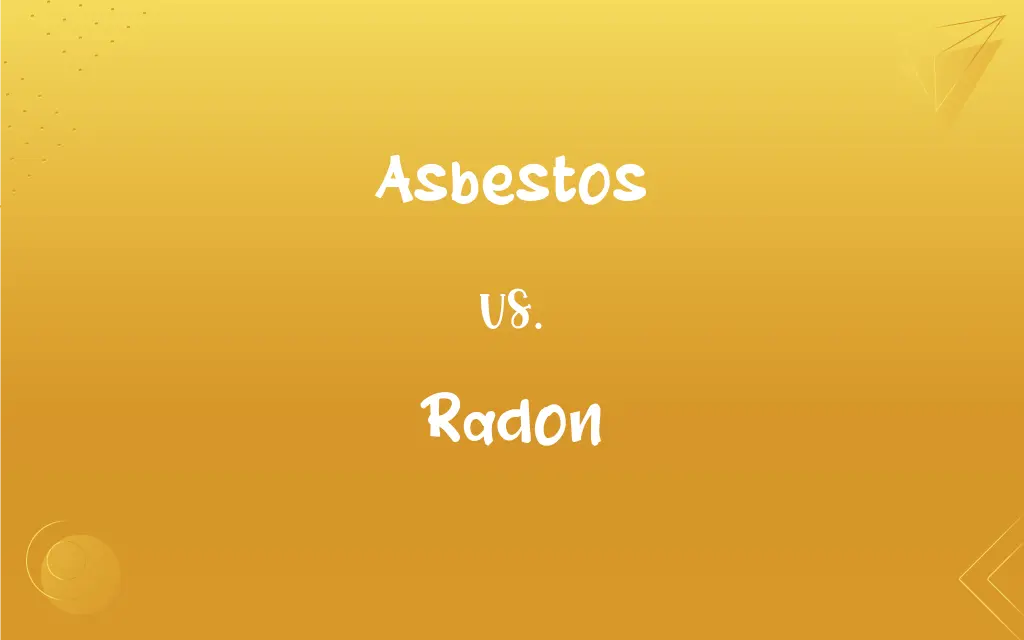Asbestos vs. Radon: What's the Difference?
Edited by Aimie Carlson || By Harlon Moss || Published on March 20, 2024
Asbestos is a group of naturally occurring fibrous minerals used in construction materials, while radon is a radioactive gas that can seep into buildings from the ground.

Key Differences
Asbestos and radon are two hazardous substances that pose significant health risks, especially in indoor environments. Asbestos is a group of silicate minerals known for their fibrous structure and resistance to heat, chemicals, and electricity. Radon, on the other hand, is a colorless, odorless, and tasteless radioactive gas that is produced by the natural decay of uranium in soil and rocks. It can seep into buildings through cracks in floors, walls, and foundations, and accumulate to high levels, particularly in enclosed spaces like basements.
The primary difference between asbestos and radon lies in their nature and source of exposure. Asbestos exposure occurs through inhalation of airborne fibers, which can be released during the handling, installation, or deterioration of asbestos-containing materials. Radon exposure, however, occurs through the inhalation of the gas that enters buildings from the ground. Both asbestos and radon are invisible threats that require proper assessment and mitigation to reduce health risks.
Understanding the hazards associated with asbestos and radon is crucial for ensuring a safe and healthy indoor environment. Asbestos-containing materials should be handled and removed by professionals to prevent the release of fibers, while radon levels in buildings should be tested and mitigated if found to be above recommended levels. Awareness and proactive measures are key to protecting individuals from the health risks posed by these substances.
Comparison Chart
Nature
Fibrous mineral
Radioactive gas
Source of Exposure
Inhalation of fibers from materials
Inhalation of gas from soil and rocks
ADVERTISEMENT
Health Risks
Asbestosis, lung cancer, mesothelioma
Lung cancer
Detection
Microscopic analysis of materials
Radon detectors and testing kits
Mitigation
Removal and abatement by professionals
Ventilation and sealing of entry points
Asbestos and Radon Definitions
Asbestos
Minerals known for their heat resistance and durability.
Asbestos was once popular in fireproofing materials.
Radon
A naturally occurring environmental hazard in certain geographic areas.
The region is known for high radon levels due to its geology.
ADVERTISEMENT
Asbestos
A group of naturally occurring fibrous minerals used in construction materials.
The old building was found to contain asbestos in its insulation.
Radon
A significant health risk when inhaled over prolonged periods.
Long-term exposure to radon increases the risk of lung cancer.
Asbestos
A hazardous substance that can cause lung diseases when inhaled.
Workers exposed to asbestos are at risk of developing mesothelioma.
Radon
A radioactive gas produced by the decay of uranium in soil.
Radon levels in the basement were found to be above the safe limit.
Asbestos
A material used in roofing, insulation, and tiles.
Asbestos tiles were commonly used in mid-20th-century homes.
Radon
A gas that requires testing and mitigation in affected buildings.
Homeowners should test for radon and install mitigation systems if necessary.
Asbestos
A substance that requires professional abatement to prevent health risks.
The renovation project included asbestos removal to ensure safety.
Radon
A colorless, odorless, and tasteless gas that can accumulate in buildings.
Radon can seep into homes through cracks in the foundation.
Asbestos
Any of six incombustible chemical-resistant silicate minerals, including one serpentine (chrysotile) and five amphiboles (amosite, crocidolite, and fibrous forms of actinolite, anthophyllite, and tremolite), that separate easily into long, thin, flexible fibers and that have been widely used commercially in products such as fireproofing, electrical insulation, building materials, brake linings, and chemical filters. Mining and use of asbestos has been restricted because inhalation of asbestos fibers can cause asbestosis and cancer.
FAQs
What are the health risks associated with asbestos?
Asbestos can cause lung diseases such as asbestosis, lung cancer, and mesothelioma.
What is radon?
Radon is a radioactive gas produced by the decay of uranium in soil and rocks.
How does asbestos exposure occur?
Asbestos exposure occurs through the inhalation of airborne fibers released from asbestos-containing materials.
How does radon exposure occur?
Radon exposure occurs through the inhalation of the gas that seeps into buildings from the ground.
What are the health risks associated with radon?
Radon is a leading cause of lung cancer, especially in non-smokers.
What measures can be taken to mitigate asbestos hazards?
Asbestos hazards can be mitigated by professional removal and abatement of asbestos-containing materials.
Is it safe to live in a house with asbestos?
It can be safe to live in a house with asbestos as long as the materials are in good condition and not disturbed.
How can radon levels be measured in a home?
Radon levels can be measured using radon detectors and testing kits.
What measures can be taken to reduce radon levels in a building?
Radon levels can be reduced through ventilation and sealing of entry points, such as cracks in the foundation.
What is asbestos?
Asbestos is a group of naturally occurring fibrous minerals used in various construction materials.
What is the significance of the EPA's action level for radon?
The EPA's action level for radon is 4 pCi/L, above which mitigation measures are recommended to reduce health risks.
Are there any safe levels of asbestos exposure?
There is no known safe level of asbestos exposure; even small amounts can pose health risks.
How can asbestos be detected in a building?
Asbestos can be detected through microscopic analysis of materials by professionals.
Can asbestos be removed by homeowners themselves?
Asbestos removal should be done by professionals due to the health risks associated with handling the material.
Is radon testing required when selling a home?
Radon testing requirements vary by location, but it is often recommended or required during real estate transactions.
How often should radon levels be tested in a home?
Radon levels should be tested every two years or after any significant changes to the home's structure.
What factors influence radon levels in a building?
Factors influencing radon levels include the geology of the area, building construction, and ventilation.
How long does it take for asbestos-related diseases to develop?
Asbestos-related diseases can take decades to develop after exposure.
Can radon be completely eliminated from a building?
While radon cannot be completely eliminated, its levels can be significantly reduced through mitigation measures.
What are the common uses of asbestos in construction?
Asbestos was commonly used in insulation, roofing, tiles, and fireproofing materials.
About Author
Written by
Harlon MossHarlon is a seasoned quality moderator and accomplished content writer for Difference Wiki. An alumnus of the prestigious University of California, he earned his degree in Computer Science. Leveraging his academic background, Harlon brings a meticulous and informed perspective to his work, ensuring content accuracy and excellence.
Edited by
Aimie CarlsonAimie Carlson, holding a master's degree in English literature, is a fervent English language enthusiast. She lends her writing talents to Difference Wiki, a prominent website that specializes in comparisons, offering readers insightful analyses that both captivate and inform.































































